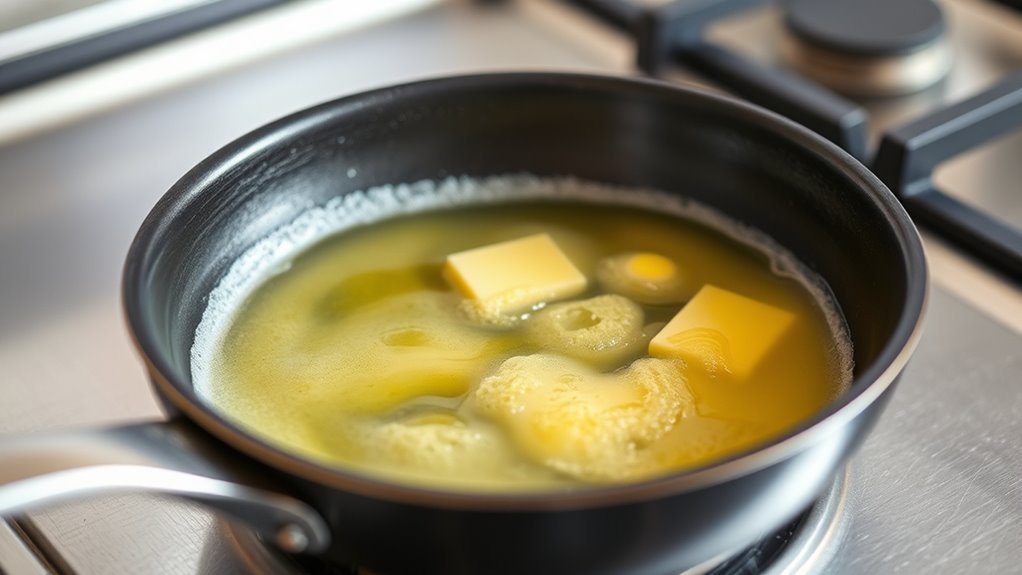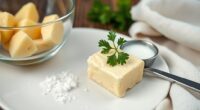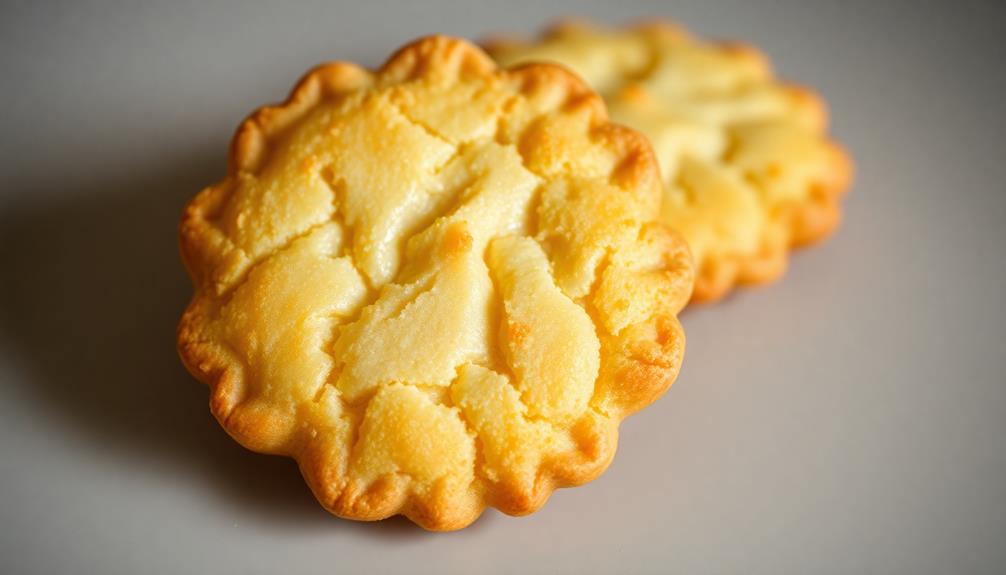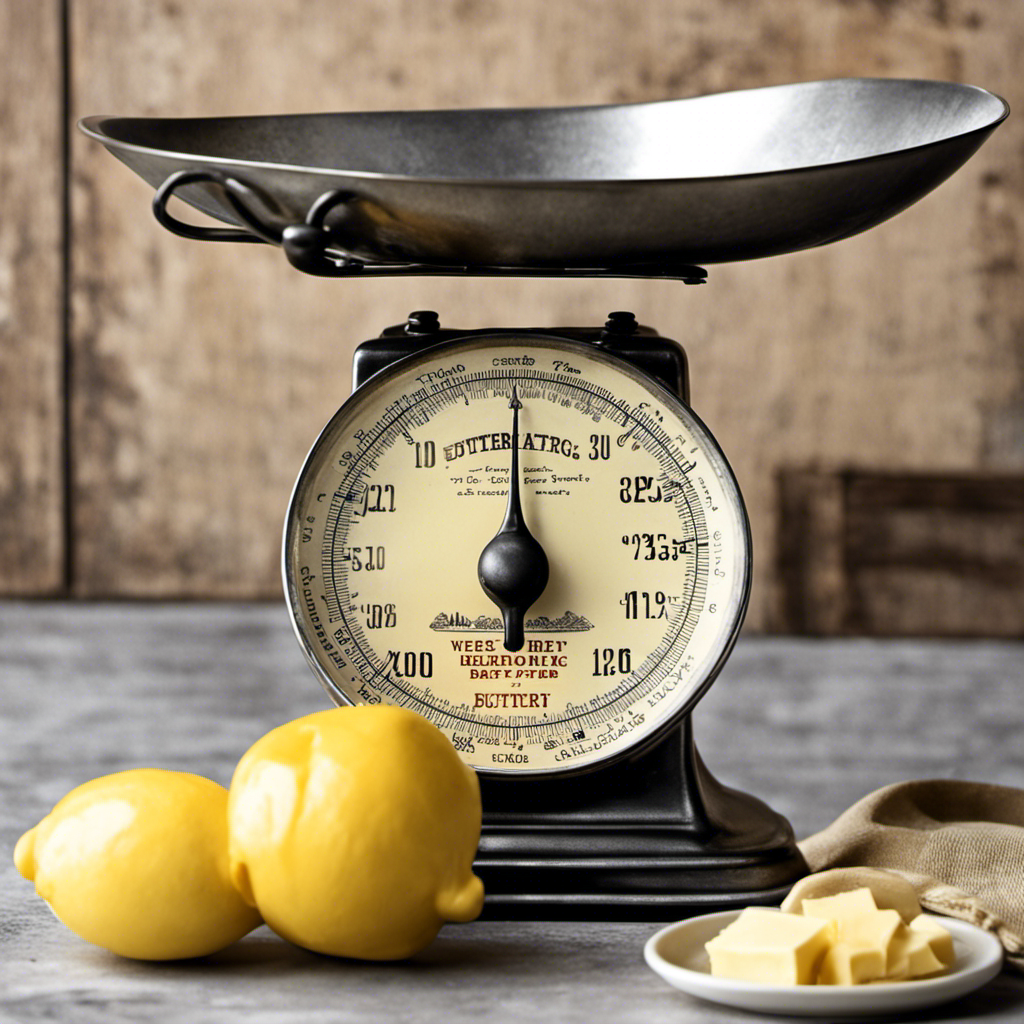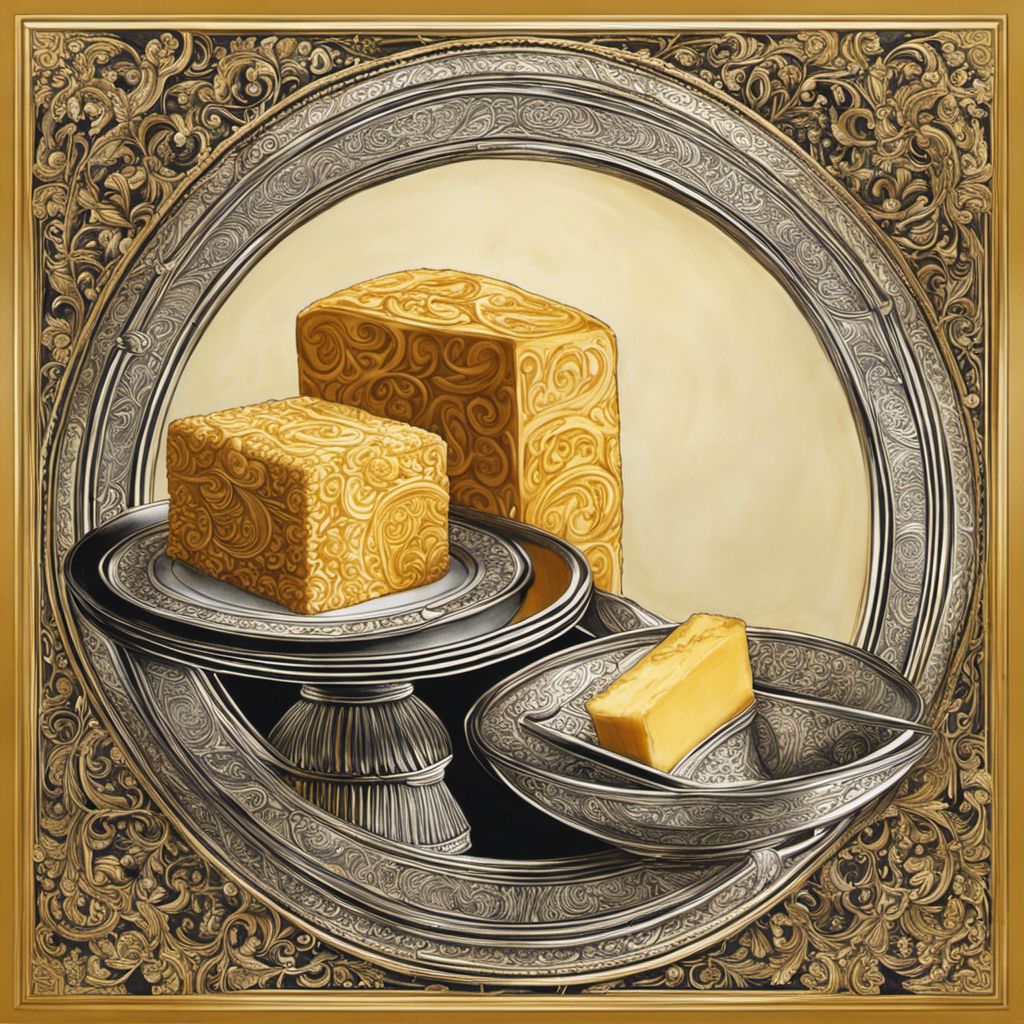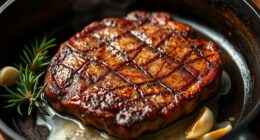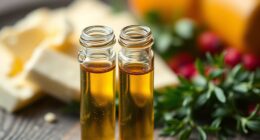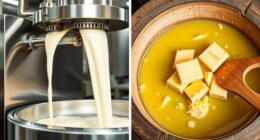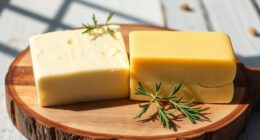To prevent butter from burning, keep the temperature between 90°F and 95°F when melting, as this avoids scorching the milk solids. Watch for bubbling and a nutty aroma as signs of melting; once it darkens or smells burnt, it’s overheating. Use gentle heat, stir often, and consider a double boiler for better control. If you want to master butter’s nuances, understanding these thresholds is key — explore more tips ahead.
Key Takeaways
- Keep butter below 90-95°F (32-35°C) during melting to prevent burning and separation of milk solids.
- Use a thermometer or visual cues like bubbling, color change, and aroma to monitor butter’s temperature closely.
- Avoid high heat; opt for low, gentle heat or a double boiler to control temperature and prevent scorching.
- Incorporate oils with higher smoke points or add liquids to disperse heat and protect butter from burning.
- Remove from heat immediately at signs of browning or strong aroma to prevent reaching the smoke point and causing burn.
Understanding the Composition of Butter and Its Melting Point
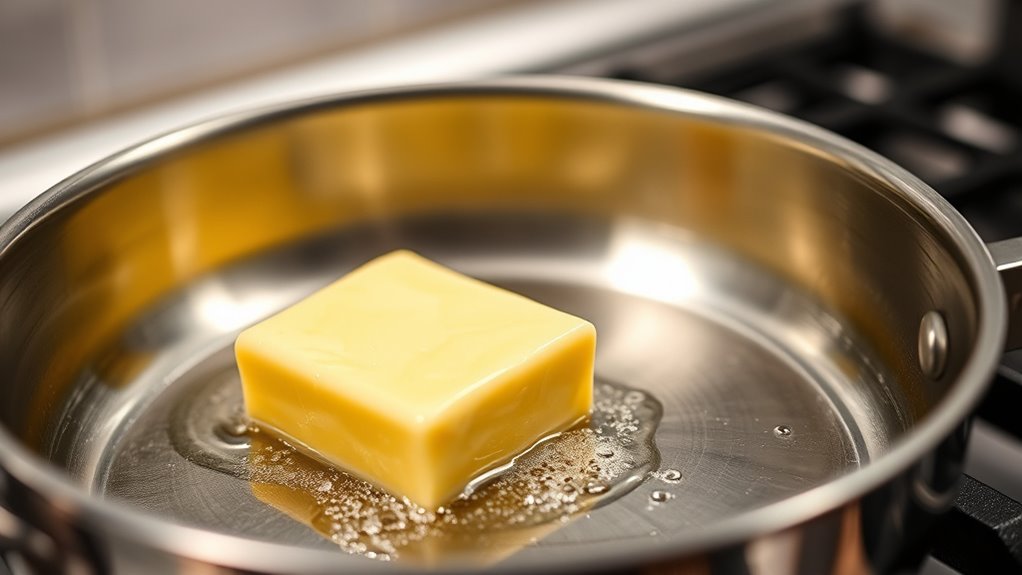
Understanding the composition of butter is essential for preventing it from burning during cooking. Butter is mainly made up of fat, water, and milk solids, which influence its melting behavior. The butter composition determines how quickly it melts and how it reacts under heat. Since butter contains about 80% fat, its melting point varies slightly depending on the fat’s composition, typically around 90-95°F (32-35°C). The water content evaporates as it heats, leaving behind milk solids that can burn easily if exposed to high temperatures. Knowing these factors helps you manage heat better. Additionally, understanding heat tolerance of butter can help you prevent burning by adjusting your cooking temperature accordingly. When you understand butter’s melting behavior, you can heat it gently, avoiding sudden temperature spikes that cause burning and ensuring a smooth, flavorful cooking process.
The Temperature Range for Melting Butter Perfectly
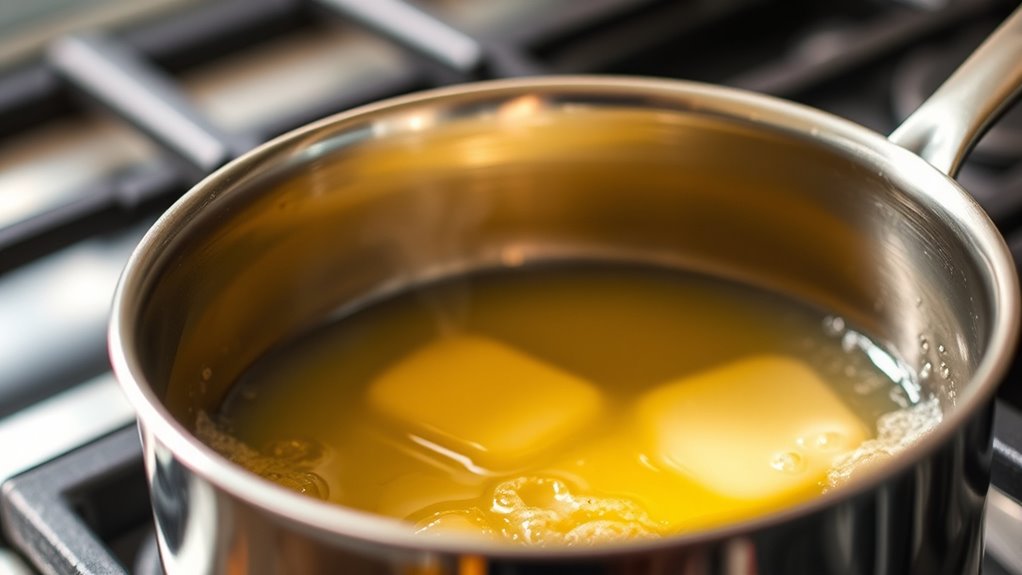
To melt butter perfectly, you need to keep the temperature within an ideal range, usually between 90°F and 95°F. Going too high can lead to overheating, causing the butter to burn or separate, while too low may result in uneven melting. Watch for signs like bubbling or a nutty smell to prevent crossing the limits and ruining your butter. Additionally, understanding temperature thresholds can help you avoid common pitfalls like butter burn during cooking.
Ideal Melting Temperature
The key to melting butter without burning it lies in maintaining the right temperature, which generally falls between 90°F and 95°F (32°C to 35°C). At this ideal melting temperature, butter preserves its rich flavor and smooth texture. If you heat it too quickly or beyond this range, you risk rapid texture changes, turning it greasy or causing it to burn. Staying within this temperature window allows the butter’s butter flavor to develop fully without losing its delicate nuances. It also ensures a uniform melt, preventing separation or clumping. Using gentle heat, such as a double boiler or low stovetop setting, helps you control this process precisely. Controlling the temperature threshold is essential for achieving the perfect melt. Mastering this temperature range guarantees perfectly melted butter every time, enhancing your cooking and baking results.
Temperature Limits for Butter
Maintaining the correct temperature range is essential for melting butter perfectly. Butter composition, which includes water, fats, and proteins, influences its melting point, typically between 90°F and 95°F (32°C to 35°C). Staying within this range ensures butter melts evenly without burning or separating. If you heat butter too low, it melts slowly and may not achieve the desired consistency for your dish. On the other hand, exceeding the melting point risks burning the milk solids, leading to a bitter taste and burnt smell. To prevent this, keep your heat steady and avoid rushing the process. Understanding these temperature limits helps you control melting, ensuring butter enhances your cooking without the risk of scorching or flavor loss.
Signs of Overheating
When butter starts to overheat, it gives clear visual and sensory warnings. You might notice a sudden bubbling or foaming as the milk solids begin to brown or burn. The butter’s aroma will change, developing a toasted or acrid smell that signals it’s beyond the ideal melting point. Its butter flavor diminishes as overheating damages delicate compounds, risking a bitter taste. You may see a darker color and a thin film on the surface, indicating loss of shelf stability. Monitoring temperature can help prevent these issues before they occur.
- Bubbling intensifies and persists
- Aroma shifts to burnt or sour notes
- Color darkens quickly
- Foam becomes thick and persistent
- Spattering increases, risking burns
Recognizing these signs helps you prevent butter from burning and preserves its flavor and shelf stability.
When Butter Begins to Brown: The Maillard Reaction Threshold
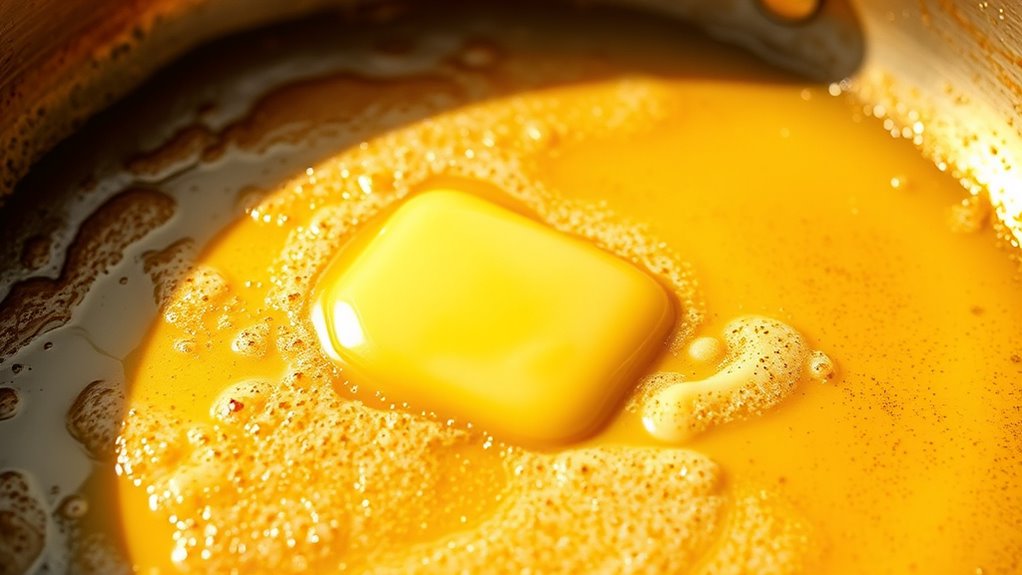
As butter heats, it reaches a point where its natural sugars and proteins react, causing it to turn golden and develop a nutty aroma. This process is known as the Maillard reaction, a key moment in butter browning. When you see the butter change from clear to light amber, you’re approaching this critical threshold. At this stage, the temperature is typically between 250°F and 300°F (120°C–150°C). The Maillard reaction enhances flavor and aroma but signals that the butter is getting close to burning. It’s essential to monitor closely, as this is the delicate window where butter transforms from beautifully browned to burnt if heated further. Recognizing this threshold helps you achieve perfect butter browning without crossing into burn territory. Being aware of the expert advice on temperature thresholds ensures better control over the browning process and prevents accidental burning.
The Exact Point Where Butter Starts to Burn
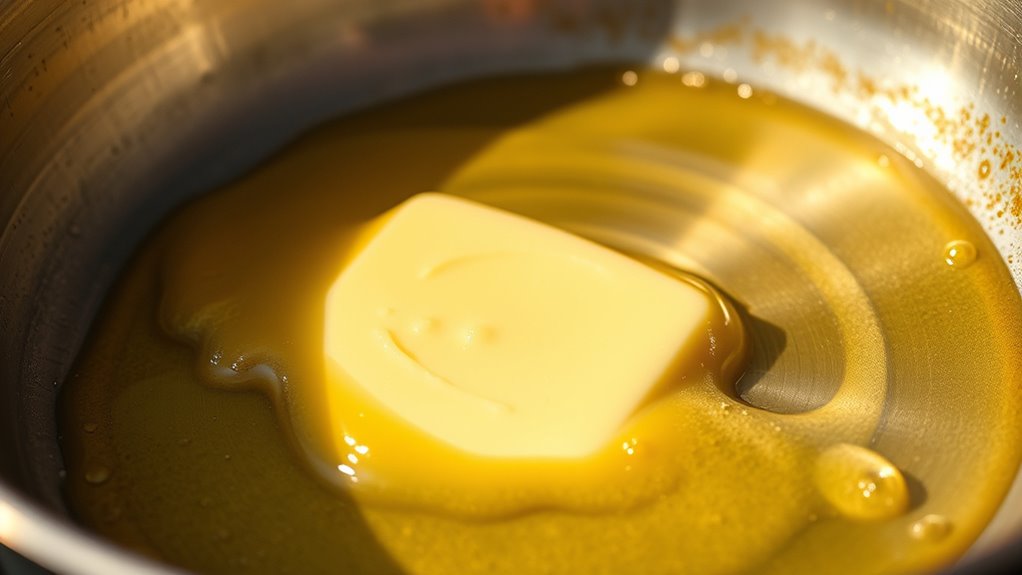
You’ll know butter is starting to burn when it reaches its smoke point, which varies but is typically around 350°F (177°C). Look for visual cues like darkening or a burnt smell, and keep a close eye on your thermometer. Monitoring temperature consistently helps you catch the moment before burning occurs. Using a cooking thermometer ensures precise control and prevents your butter from reaching its burning point.
Smoke Point of Butter
Have you ever wondered exactly when butter begins to burn during cooking? That’s when the clarifying smoke point comes into play. The clarifying smoke point is the temperature at which butter’s unique composition causes it to emit smoke. Regular butter’s smoke point typically ranges from 300°F to 350°F, depending on its butter composition. When you heat butter past this point, its milk solids start to burn, leading to a bitter taste and smoke. To imagine this, consider:
- Milk solids turning dark and smelly
- Aromatic compounds breaking down
- Emission of bluish smoke
- Butter’s aroma becoming acrid
- Temperature surpassing safe cooking limits
Knowing this threshold helps you prevent burning, ensuring your dishes stay flavorful and visually appealing.
Visual Cues of Burning
When butter reaches the point of burning, several clear visual cues signal that it’s gone beyond its safe cooking temperature. You’ll notice the color darkening from golden to a deep brown or black, indicating it’s starting to burn. Foam may become more vigorous, and the butter’s surface might appear uneven or scorched. Aroma indicators are also telling—burning butter produces a sharp, acrid smell that quickly alerts you to stop heating. You might detect a bitter or smoky scent, which confirms the butter has surpassed its ideal temperature. Recognizing these visual cues and aroma indicators early helps prevent burnt butter, preserving flavor and preventing waste. Additionally, understanding creative practice can help you develop a keen sense of observation that allows you to catch these cues more effectively. Stay attentive to these signals as you cook to maintain perfect butter while avoiding the bitter taste of burnt fat.
Temperature Monitoring Tips
Monitoring the temperature of butter closely is essential to prevent it from burning. When butter overheats, it can lead to cream separation, which affects both texture and flavor. To keep control, use a reliable thermometer and stay attentive as you cook. Utilizing a free online tool to quickly convert text into various capitalization styles can help you create clear and consistent cooking notes or labels. Look for these signs:
- Butter bubbling steadily without browning
- Slight foam formation on the surface
- No dark spots or burnt smell
- Consistent, gentle simmer
- Maintaining a smooth, shiny appearance
Keeping butter within the right temperature range preserves its flavor enhancement qualities and prevents cream separation. Regularly checking the thermometer helps you catch the moment just before burning, ensuring your dish retains its rich taste and ideal texture.
Signs of Overheated Butter During Cooking
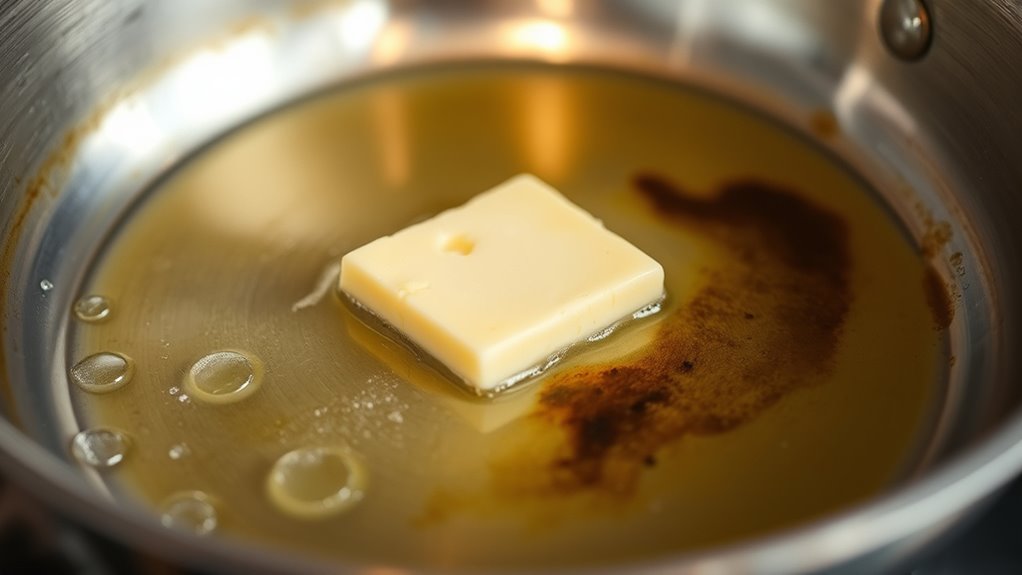
As butter overheats, it quickly reveals its distress through visible signs. You’ll notice a darkening in color, shifting from golden yellow to a deeper brown or even black if it burns. The butter’s aroma also changes, developing a strong, nutty or acrid smell that signals it’s starting to burn. When overheated, the butter’s delicate flavor diminishes, and its original rich butter flavor turns bitter, compromising your dish’s taste. This not only affects the flavor but also limits its culinary versatility, making it unsuitable for delicate sauces or baked goods. You might also see bubbling vigorously or even foam, indicating it’s reached a critical temperature. Recognizing these signs early helps prevent burnt butter and preserves both flavor and culinary potential. Additionally, understanding temperature thresholds can help you control heat more effectively and avoid reaching these damaging temperatures.
Best Practices for Maintaining Optimal Butter Temperature

Maintaining the right butter temperature requires attentiveness and quick adjustments throughout your cooking process. To preserve butter flavor and prevent burning, you should monitor heat levels carefully, adjusting as needed. Use a double boiler or low, even heat to avoid hotspots. Keep butter away from direct flames to prevent rapid temperature spikes. Store butter properly—preferably in an airtight container in the fridge—to guarantee freshness and consistent quality. When melting, do so slowly, stirring frequently to distribute heat evenly. Consider using a thermometer to keep butter within the ideal temperature range. Additionally, choose the right pan—preferably heavy-bottomed—to maintain steady heat. Understanding the importance of temperature thresholds can help you better control heat levels and prevent unwanted burning. These best practices help you control butter temperature, safeguard flavor, and prevent unwanted burning.
Tips for Using Butter in Different Cooking Techniques
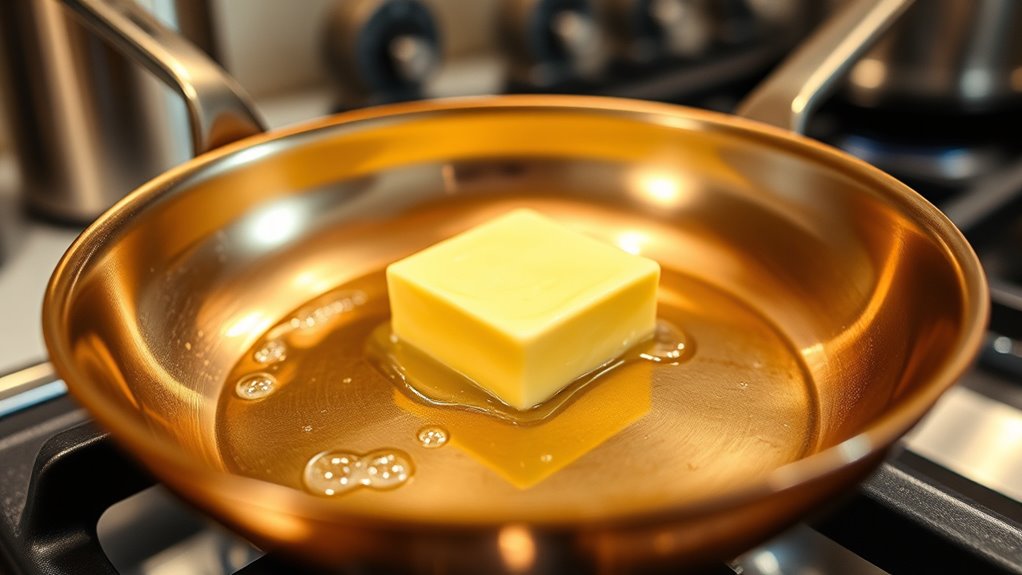
Using butter effectively across different cooking techniques can elevate your dishes, but each method requires specific handling to prevent burning and preserve flavor. Proper butter storage keeps it fresh and prevents spoilage, ensuring ideal flavor profiles. When sautéing or pan-frying, use clarified butter or mix butter with oil to raise the smoke point and avoid burning. For baking, use unsalted butter at room temperature for even mixing and better control over flavor. When browning butter, do so gently over moderate heat, allowing the nutty aroma to develop without burning. Recognize that butter flavor profiles—ranging from sweet and mild to rich and nutty—are influenced by how you handle it. Adjust your technique accordingly to maximize taste and prevent unwanted burn spots.
How to Prevent Butter From Burning When Making Sauces and Sautés
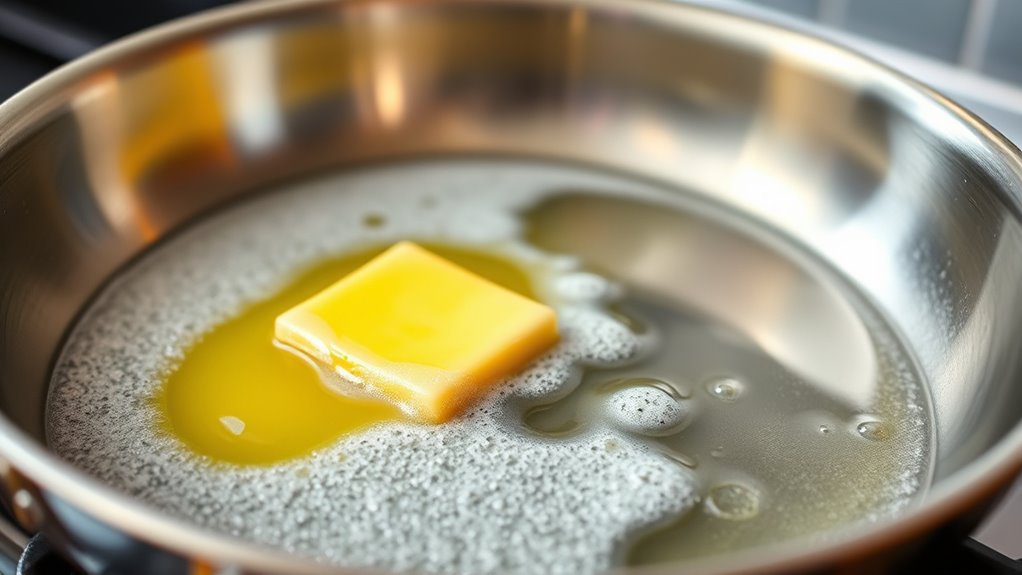
To prevent butter from burning when making sauces and sautés, it’s essential to control the cooking temperature and choose the right type of butter. Using clarified or butter with higher smoke points reduces the risk of burning, preserving its rich butter flavor and nutritional content. Keep these tips in mind:
- Use medium or low heat to avoid overheating the butter.
- Incorporate oils with higher smoke points, like grapeseed or avocado, alongside butter.
- Add butter later in the cooking process to prevent direct heat exposure.
- Stir constantly to distribute heat evenly.
- Consider using browned butter (beurre noisette) for a nutty flavor without burning.
These practices help maintain the butter’s flavor, prevent burning, and preserve its nutritional benefits during sauce-making and sautéing.
Troubleshooting Common Butter Burning Issues in the Kitchen
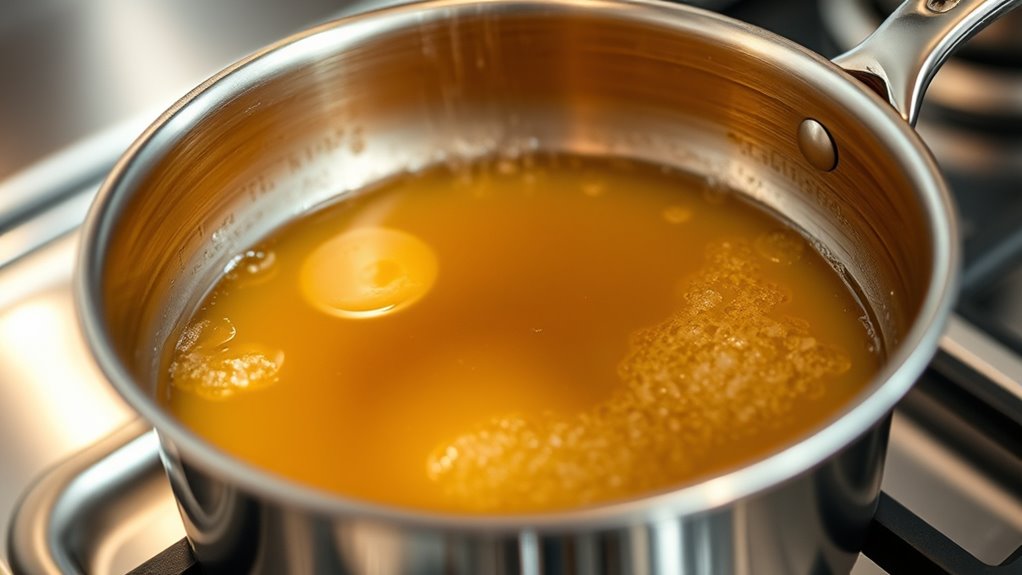
When butter starts to burn in the kitchen, it can quickly ruin your dish and create smoke that’s difficult to clear. To troubleshoot this, first check your butter storage—keeping butter at room temperature for too long can cause uneven melting and burning. Using fresh, properly stored butter helps preserve its flavor and prevents it from scorching easily. When cooking, monitor the heat closely; butter burns quickly once it exceeds its smoke point. If you notice browning too fast, lower the heat immediately or add a splash of liquid to disperse the heat. Stirring constantly also helps prevent hotspots. Remember, removing butter from direct heat once it’s melted can save your dish and maintain that rich, buttery flavor you’re after.
Frequently Asked Questions
Can the Type of Butter Affect Its Burning Point?
Yes, the type of butter affects its burning point because butter composition varies, especially in fat content and moisture levels. Different butters have distinct fat melting points, which influence how quickly they burn. For example, clarified butter or ghee has a higher burning point than regular butter because it contains less water. Knowing these differences helps you cook at the right temperature and prevent burning.
How Does Altitude Influence Butter Temperature Thresholds?
Altitude effects can influence how quickly butter melts and burns. At higher altitudes, lower air pressure causes water in butter to evaporate faster, making butter melt at slightly lower temperatures. This means you need to be more attentive when cooking butter at high elevations to prevent burning. Keep a close eye on temperature thresholds, and consider adjusting your heat to avoid overheating and burning your butter during cooking.
Are There Alternative Fats With Higher Burn Points?
Imagine your pan as a busy highway; some fats are like sports cars, racing at higher speeds. You’d choose oils with higher burn points—like avocado or refined coconut oil—when cooking at high heat. These alternatives resist burning better than butter. To keep butter flavorful, consider adding butter flavorings after cooking, and store your butter properly with correct butter storage tips to preserve its rich taste without risking a burn.
Does Salted or Unsalted Butter Burn at Different Temperatures?
You might wonder if salted or unsalted butter burns at different temperatures. While their melting points are nearly identical, the added salt in salted butter can slightly affect its butter flavor and how it behaves when heated. However, the burning temperature mainly depends on the butter’s composition, not whether it’s salted or unsalted. To avoid burning, keep an eye on the temperature and use clarified butter for higher heat cooking.
How Do Cookware Materials Impact Butter’s Temperature Limits?
Think of cookware materials as the stage for your cooking performance. Copper and aluminum conduct heat like lightning, ensuring even heat transfer that keeps butter from burning. Cast iron, being slower, acts like a steady drumbeat, requiring careful heat control. Your choice of cookware directly impacts butter’s temperature limits, as different materials absorb and transfer heat differently—affecting how quickly butter reaches its burning point and how much attention you need to give during cooking.
Conclusion
So, next time you’re tempted to rush your butter, remember these temperature thresholds. Ironically, the very thing that makes butter so delicious—its rich fats—can turn your dish into a burnt disaster if you’re not careful. Master the heat, and you’ll avoid the smoky mess, proving that sometimes, the best way to prevent burning is simply knowing when to stop. After all, patience is the secret ingredient—unless you like your butter extra crispy.
